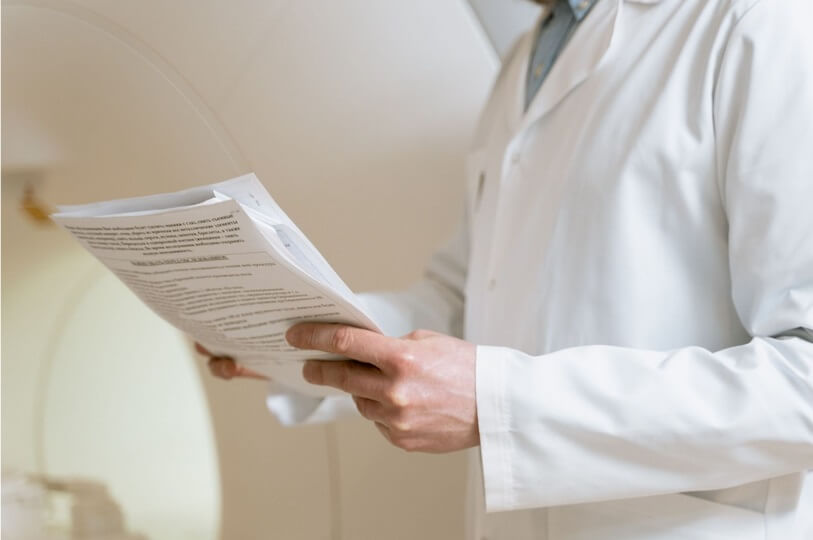Information
Cervical decompressive laminectomy is a surgical procedure commonly used to address multilevel cervical spondylotic myelopathy, a condition characterized by the compression of the spinal cord due to degenerative changes in the cervical spine. While this procedure can effectively relieve pressure on the spinal cord and alleviate symptoms, there is a concern that it may lead to kyphotic deformity in some cases, potentially resulting in neurological decline.
Kyphotic deformity refers to an abnormal forward curvature of the spine in the cervical region, which can lead to a loss of the normal lordotic curvature (backward curve) in the neck. Kyphosis can cause various issues, including spinal cord compression, neurological deficits, and worsening symptoms.
To address these concerns and reduce the risk of postoperative kyphotic deformity, cervical laminectomy with fusion using lateral mass instrumentation has gained popularity. This surgical approach combines laminectomy (removing a portion of the lamina to relieve pressure on the spinal cord) with spinal fusion (joining two or more vertebrae together) and the use of lateral mass instrumentation (hardware designed to stabilize and support the spine). The fusion and instrumentation help maintain proper alignment and prevent kyphotic deformity.
The goal of this approach is to improve long-term neurological outcomes by reducing the risk of postoperative kyphotic deformity and maintaining spinal stability. It's important for individuals with cervical spondylotic myelopathy to work closely with their healthcare providers and spine surgeons to determine the most appropriate surgical approach based on their specific condition and needs. The choice of surgical technique should be tailored to the individual to achieve the best possible outcomes.
Cervical laminectomy, both with and without fusion, is an effective surgical approach for decompressing the spinal cord in cases of symptomatic multilevel cervical spondylotic myelopathy. This procedure helps alleviate pressure on the spinal cord, relieving symptoms and improving the patient's condition. However, there are some important considerations when deciding between laminectomy with or without fusion, and they are related to the development of postoperative kyphosis and other factors.
Incidence of Postlaminectomy Kyphosis: Postlaminectomy kyphosis refers to an abnormal forward curvature of the cervical spine that can develop after a laminectomy. The incidence of postlaminectomy kyphosis is lower when posterior fusion is performed, as fusion helps maintain spinal stability and alignment. This is one of the advantages of posterior fusion in comparison to laminectomy alone.
Clinical-Radiologic Correlation: It's noted that while postlaminectomy kyphosis can occur, there isn't always a strong clinical-radiologic correlation. This means that not all patients who develop postoperative kyphosis will experience clinical symptoms, such as myelopathy (spinal cord dysfunction). Some individuals may have radiologic evidence of kyphosis but not necessarily show clinical signs or symptoms.
Additional Risks of Posterior Instrumentation: While posterior fusion with instrumentation can help reduce the risk of kyphosis, it also introduces specific risks associated with the hardware used for stabilization. Complications related to posterior instrumentation include infection, hardware-related issues, and the need for revision surgeries. These potential risks need to be carefully considered when deciding on the surgical approach.
Ultimately, the choice between laminectomy alone or laminectomy with fusion depends on the specific patient's condition, the severity of cervical spondylotic myelopathy, the presence of deformity or instability, and the goals of the surgery. Patients should work closely with their spine surgeon to assess the risks and benefits of each approach and make an informed decision that best addresses their individual needs and concerns.
Lateral mass screw fixation is a surgical technique used in the cervical spine to stabilize the vertebrae by anchoring screws into the lateral masses of the cervical vertebrae. This procedure is often employed to treat various cervical spine conditions, such as instability, deformity, or to support a fusion procedure. Here's a more detailed explanation of lateral mass screw fixation in the cervical spine:
- Lateral Mass of the Cervical Spine: The cervical spine consists of seven vertebrae (C1 to C7) located in the neck region. Each cervical vertebra has two lateral masses on each side of the vertebral body, which are bony structures that extend outward. These lateral masses provide a stable and relatively flat surface for the placement of screws.
- Surgical Procedure: During a lateral mass screw fixation procedure, a surgeon makes an incision in the back of the neck and uses specialized instruments to access the cervical spine. X-ray guidance is often used to precisely place the screws. The screws are typically made of metal and are anchored into the lateral masses of the cervical vertebrae.
- Indications: Lateral mass screw fixation is often used in the following situations:
- Stabilization of the cervical spine following the removal of a damaged disc during an anterior cervical discectomy and fusion (ACDF) procedure.
- Correction of cervical spine deformities or instability.
- Providing support for a cervical fusion procedure, where two or more vertebrae are fused together to eliminate motion at the affected segment.
- Treatment of conditions such as cervical spondylotic myelopathy (compression of the spinal cord in the neck) or cervical fractures.
- Risks and Considerations: As with any surgical procedure, lateral mass screw fixation comes with potential risks, such as injury to nearby structures (nerves, blood vessels, or the spinal cord), infection, or hardware-related issues. The procedure's success largely depends on the surgeon's experience and the patient's specific condition.
Lateral mass screw fixation is an important surgical technique that can provide stability and support for the cervical spine. The decision to undergo this procedure is typically made in consultation with a spine specialist who assesses the patient's condition and determines the most appropriate surgical approach.
Types
Cervical laminectomy and lateral mass fixation is a surgical procedure used to treat various cervical spine conditions, particularly those that involve the removal of the lamina (the bony arch on the back of a vertebra) and the stabilization of the cervical spine through the use of screws or other hardware anchored into the lateral masses of the cervical vertebrae. The specific type of procedure can vary based on the extent of the surgery and the approach used. Here are some common types of cervical laminectomy and lateral mass fixation procedures:
- Cervical Laminectomy and Lateral Mass Fixation with Fusion (Laminoplasty): This procedure involves the removal of the lamina and the expansion of the spinal canal to relieve pressure on the spinal cord. Lateral mass fixation is then used to stabilize the cervical spine. In some cases, bone grafts or other fusion techniques may also be employed to promote spinal stability.
- Cervical Laminectomy and Lateral Mass Fixation without Fusion: In cases where fusion is not required, the procedure may involve the removal of the lamina and the placement of lateral mass screws to provide stability without fusion. This is often considered for certain conditions where preserving motion at the treated level is desirable.
- Cervical Laminectomy and Lateral Mass Fusion (Unilateral or Bilateral): Depending on the patient's condition, either unilateral (one-sided) or bilateral (both sides) cervical laminectomy and lateral mass fixation with fusion may be performed. This decision is typically based on the extent of spinal cord compression or nerve root involvement.
- Zero-Profile Lateral Mass Fixation: In some cases, a zero-profile lateral mass fixation technique may be used. This involves using specialized plates and screws that provide stability without causing as much prominence as traditional hardware. It reduces the risk of post-operative complications related to hardware.
- Cervical Laminectomy and Lateral Mass Fixation with Dynamic Stabilization: Dynamic stabilization devices are used to maintain motion at the treated level while providing stability. This technique is sometimes used when motion preservation is a primary concern.
- Minimally Invasive Cervical Laminectomy and Lateral Mass Fixation: Minimally invasive techniques use smaller incisions and specialized instruments to access the cervical spine. This approach aims to reduce post-operative pain and speed up recovery, while still achieving the goals of laminectomy and lateral mass fixation.
The choice of the specific type of cervical laminectomy and lateral mass fixation procedure depends on the patient's diagnosis, the extent of spinal cord or nerve compression, the need for spinal stability, and the surgeon's judgment regarding the most appropriate surgical approach. The decision should be made in consultation with a spine specialist who can assess the individual patient's condition and determine the best surgical strategy.
Benefits
This procedure offers several potential benefits for patients with specific spinal issues. Here are some of the key advantages:
- Spinal Decompression: The removal of the lamina in a cervical laminectomy helps decompress the spinal cord and nerves. This can alleviate symptoms caused by spinal cord or nerve compression, such as pain, weakness, numbness, and tingling.
- Restoration of Spinal Alignment: Cervical laminectomy and lateral mass fixation can correct cervical spine deformities, restore proper alignment, and prevent further progression of conditions like cervical spondylotic myelopathy or cervical stenosis.
- Pain Relief: By relieving pressure on the spinal cord and nerve roots, the procedure can significantly reduce or eliminate neck and arm pain associated with cervical spine disorders.
- Stabilization of the Cervical Spine: Lateral mass fixation provides stability to the cervical spine. This is particularly important when the lamina has been removed, as it helps prevent postoperative instability and maintains spinal alignment.
- Improved Neurological Function: The surgery can improve or prevent the deterioration of neurological function, which may have been affected by spinal cord compression. It can help patients regain lost sensation and motor function.
- Prevention of Further Damage: By addressing the underlying spinal condition, cervical laminectomy and lateral mass fixation can help prevent the condition from worsening and causing more severe neurological deficits over time.
- Potential for Motion Preservation: In cases where fusion is not performed, the procedure can maintain motion at the treated level, allowing for some degree of mobility at the cervical spine segment. This is especially important for maintaining normal neck function.
- Minimally Invasive Options: Minimally invasive techniques can be employed for cervical laminectomy and lateral mass fixation, which often result in smaller incisions, reduced tissue disruption, less post-operative pain, and quicker recovery.
- Improved Quality of Life: For many patients, relief from pain, improved mobility, and the prevention of further neurological deterioration can significantly enhance their overall quality of life.
- Reduced Risk of Future Complications: By addressing cervical spine issues surgically, patients may reduce the risk of developing complications associated with long-term spinal cord or nerve compression, such as permanent nerve damage.

It's important to note that while cervical laminectomy and lateral mass fixation offer several benefits, there are also potential risks and considerations associated with the procedure, including the possibility of complications like infection, hardware-related problems, or injury to nearby structures. The decision to undergo this surgery should be made in consultation with a spine specialist, who will evaluate the patient's specific condition and recommend the most appropriate treatment approach based on their individual needs and circumstances.
Surgical Procedure:
The surgical procedure you described appears to be a cervical laminectomy, which is a surgical technique used to address spinal cord compression or stenosis in the cervical (neck) region. Here's a summary of the key steps in the procedure:
- Anesthesia: The patient is put under general anesthesia to ensure unconsciousness during the operation.
- Patient Positioning: The patient is positioned lying face-down (prone) on the operating table.
- Incision: A surgical incision is made in the back of the neck to access the cervical spine.
- Exposure: The muscle tissue around the spine is gently moved aside, and a retractor is used to provide a clear view of the spinal structures.
- Lamina Removal: The surgeon carefully removes the lamina, which are the bony arches that cover the spinal cord and canal. This step allows access to the spinal cord and surrounding structures.
- Bone Thinning: On one side of the spine, a burr (surgical tool) is used to create a narrow groove in the bone, effectively thinning it. This allows the bone on that side to act as a hinge.
- Lamina Opening: The thinned bone acts as a hinge, and the lamina arches are gently opened to relieve pressure on the spinal cord.
- Bone Grafts and Hardware: Small bone grafts are used to maintain the arches in an open position. Titanium plates and screws are used to secure the grafts in place.
- Drainage Tube: A drainage tube may be placed under the muscle layers before closing the incision to prevent blood or drainage from accumulating beneath the wound.
- Closure: The incision is closed with resorbable stitches placed beneath the skin.
The duration of the surgery is approximately 2 hours. This procedure is typically performed to relieve spinal cord compression caused by conditions such as cervical stenosis, herniated discs, or bone spurs in the cervical spine. It aims to alleviate pressure on the spinal cord and improve the patient's neurological symptoms.
After Surgery:
After the surgery, the patient is taken to the recovery room, where they stay for about an hour. During this time, the medical team monitors the patient's vital signs and ensures a smooth transition from the operating room to the recovery area.
The surgeon will also take the opportunity to speak to the patient's family, providing updates on the procedure and the patient's condition. This communication helps keep the family informed and reassured about their loved one's well-being.
Once in the recovery room, the medical staff will assist the patient in getting out of bed. Early mobilization is an important aspect of the recovery process after spine surgery. A physical therapist may also work with the patient to assess their strength and mobility and provide guidance on the initial stages of post-operative movement and exercises.
It's notable that the patient is encouraged to walk the morning after surgery, which is a positive step towards early ambulation and recovery. Typically, patients are discharged on the second day after surgery, following a successful recovery in the hospital.
Recovery and rehabilitation continue after discharge, and the patient should follow their surgeon's instructions for post-operative care, including activity restrictions, pain management, and any necessary follow-up appointments.
After Going Home:
- The patient will be prescribed pain medication and muscle relaxants to help control post-operative pain and muscle spasms. These medications are important for comfort during the early stages of recovery.
- It's essential to avoid driving or operating heavy machinery while taking pain medications, as they can cause drowsiness and impair motor skills. Patients should follow their surgeon's recommendations regarding when it's safe to resume these activities, which, in this case, is typically after two weeks.
- The patient will be required to wear a soft neck brace for two weeks after surgery. The brace provides support to the neck and helps with the healing process.
- Patients can generally return to sedentary office or desk work about two weeks after surgery. This allows for a gradual return to normal activities and can vary depending on the patient's individual progress.
- Patients engaged in manual labor that involves heavy lifting should wait for at least three months before returning to these activities. This extended period ensures that the neck has sufficient time to heal and regain strength. However, patients can typically resume moderate-duty work at 4-6 weeks.
- Patients can gradually resume sports activities such as running, golf, or tennis around the three-month mark. It's important to be cautious and follow any specific recommendations provided by the surgeon.

The recovery timeline and instructions can vary from patient to patient, and it's crucial for individuals to closely follow the guidance of their surgeon to ensure a successful recovery. Regular follow-up appointments with the surgeon will help monitor progress and make any necessary adjustments to the post-operative plan.
Potential Risks and Complications:
It's essential for patients to be aware of these risks before undergoing the surgery. Here are some of the potential risks and complications associated with cervical laminectomy:
- Nerve Root Damage (0.5-1%): During the procedure, there is a small risk of damage to a nerve root, which may result in neurological symptoms. The risk is relatively low, but it's an important consideration.
- Dural Tear (1-3%): A dural tear refers to a tear in the membrane that surrounds the spinal cord and contains cerebrospinal fluid. While these tears are usually recognized during the procedure and can be repaired immediately, they may cause spinal fluid leakage. In some cases, dural tears may be recognized after surgery, necessitating further management, such as a period of lying flat to allow the tear to heal or possible additional surgery.
- Infection (1-2%): There is a risk of post-operative infection following cervical laminectomy. Infections can occur at the surgical site and may require treatment with antibiotics.
- Bleeding Requiring Transfusion: Some patients may experience post-operative bleeding that requires a blood transfusion. This risk varies among individuals and may be influenced by their overall health and medical condition.
- Medical Complications: Patients undergoing cervical laminectomy may experience medical complications such as heart attacks, strokes, blood clots, and pneumonia. The risk of these complications depends on the patient's medical condition and age. Patients with pre-existing health issues may be at higher risk.
It's important to note that while these risks exist, the majority of cervical laminectomy surgeries are successful without complications. Surgeons take precautions to minimize these risks, and prompt identification and management of any issues during or after surgery can help mitigate potential complications.
Patients should discuss the specific risks and complications with their surgeon before the procedure and adhere to pre-operative and post-operative instructions to reduce the likelihood of these adverse events. Additionally, regular follow-up appointments are crucial to monitor the patient's recovery progress and address any concerns promptly.


